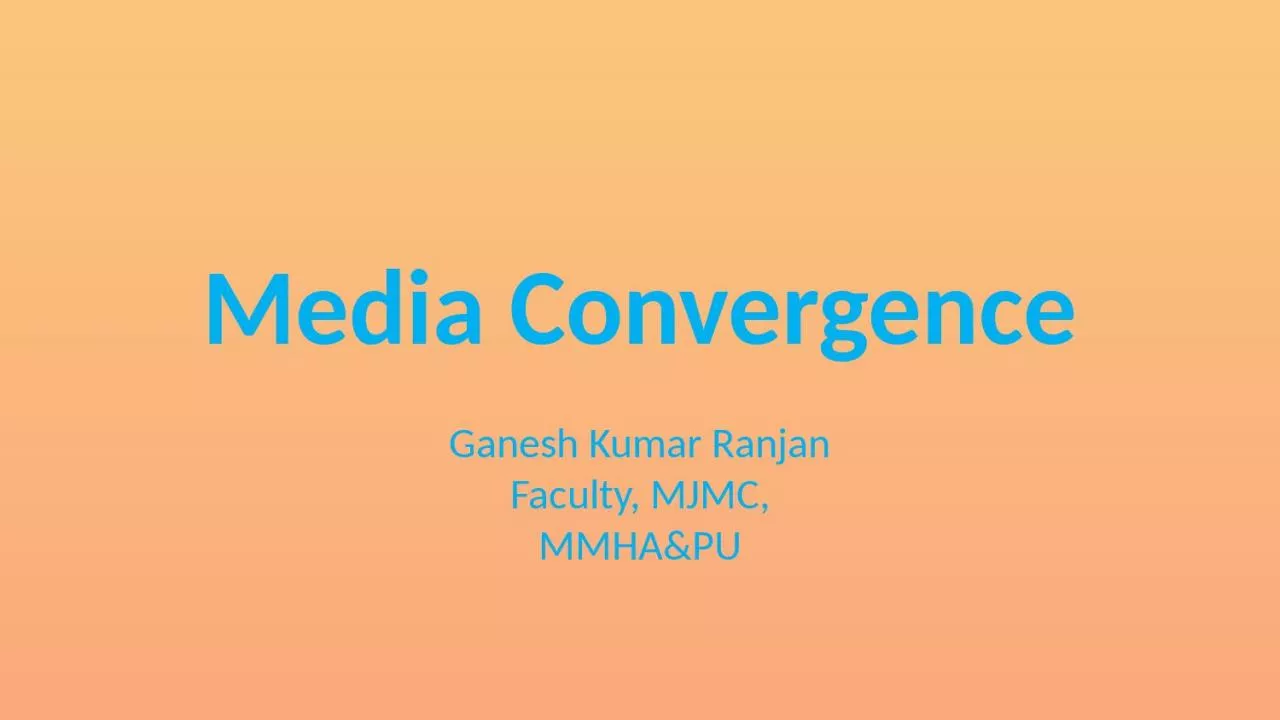

Kumar Ranjan Faculty MJMC MMHAampPU Convergence Convergence comes from the prefix con together verge to turn toward Convergence can be used to describe things that are in the process of coming together like the slow convergence of your opinion with those of your friends mother ID: 1020930
Download Presentation The PPT/PDF document "Media Convergence Ganesh" is the property of its rightful owner. Permission is granted to download and print the materials on this web site for personal, non-commercial use only, and to display it on your personal computer provided you do not modify the materials and that you retain all copyright notices contained in the materials. By downloading content from our website, you accept the terms of this agreement.
1. Media ConvergenceGanesh Kumar RanjanFaculty, MJMC,MMHA&PU
2. ConvergenceConvergence comes from the prefix con- together verge- to turn towardConvergence can be used to describe things that are in the process of coming together, like the slow convergence of your opinion with those of your friends, mothers, or for the things that have already come together, like the convergence of roads.Convergence used to be defined as multiple media- a newspaper and a television station and a radio station and a website working together to best tell a story.
3. Defining media convergenceThe flow of content across multiple media platforms, the cooperation between multiple media industries and the migratory behaviour of media audiences who will go almost anywhere in search of the kinds of entertainment experiences they want. Convergence is a word, that manages to describe technological , industrial, cultural, and social change(Henry Jenkings,2000).
4. What convergence stands for?Convergence is increasingly prevalent in IT world. In this context, the term refers to the combination of two or more different technologies in a single device. Taking pictures with a cell phone and surfing the web on a television are two of the most common example of this trend.
5. Need for media convergenceTechnological rich societies have entered the digital age. Media industries are grapping with new opportunities and threats- offered by what is called “convergence”. Media people tend to get very excited about convergence because it hold so much promise. The melding together of different media, incorporating new personalized service is both impressive and overwhelming.According to media theorist Henry Jenkins ‘ convergence is not an end result but instead a process that change how media is consumed and produced’.
6. Jenkins categories convergence in to five: Global Convergence Technical Convergence Economic Convergence Cultural Convergence Organic ConvergenceMedia convergence Type
7. Economic convergence , when a single company has interests across many kinds of media.Organic convergence is multimedia , multitasking or the “natural” outcome of a diverse media world.Cultural convergence, when stories flow across several kinds of media platforms, and when readers or viewers can comment on alter or otherwise talk back to culture.Global convergence , when geographically distant culture are able to influence one-another.Technological convergence, in which different kinds of technologies merge. The most extreme example of technological convergence would be the as yet hypothetical “Blackbox” one machine that control every media function.
8. According o Graham Meikle and Sherman Young, convergence can be understood in four dimensions:TechnologicalIndustrialSocialTextual
9. Technological- the combination of computing, communication and content across networked digital media platforms.Industrial- the engagement of established media institution in the digital media space and the rise of digitally based companies such as Google, Apple, Microsoft and others as a significant media content providers.Social- the rise of social network media such as Facebook, twitter and Youtube and the growth of user created contentTextual- the reuse and remixing of media in to what has been termed as a ‘ trans-media’ model where stories and media content (sound, image, text) are dispersed across multiple media platforms.